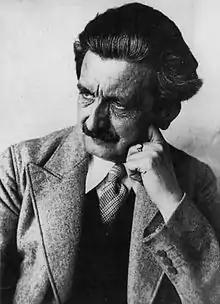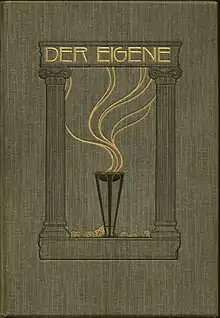Adolf Brand
Gustav Adolf Franz Brand (14 November 1874 – 2 February 1945) was a German writer, egoist anarchist, and pioneering campaigner for the acceptance of male bisexuality and homosexuality.
Adolf Brand | |
|---|---|
 | |
| Born | 14 November 1874 |
| Died | 2 February 1945 (aged 70) |
| Nationality | German |
| Occupation(s) | School teacher, journal publisher, writer |
Early life
Adolf Brand was born on 14 November 1874 in Berlin, which was then part of the German Empire.
Career

He became a school teacher briefly before establishing a publishing firm and producing a German homosexual periodical, Der Eigene (The Unique) in 1896. This was the first ongoing homosexual publication in the world,[1] and ran until 1931. The name was taken from writings of egoist philosopher Max Stirner, who had greatly influenced the young Brand, and refers to Stirner's concept of "self-ownership" of the individual. Der Eigene concentrated on cultural and scholarly material, and may have had an average of around 1500 subscribers per issue during its lifetime, although the exact numbers are uncertain. Contributors included Erich Mühsam, Kurt Hiller, John Henry Mackay (under the pseudonym Sagitta) and artists Wilhelm von Gloeden, Fidus and Sascha Schneider. Brand contributed many poems and articles himself. Brand's writings, together with those of other contributors to Der Eigene, aimed at a revival of Greek pederasty as a cultural model for modern homosexuality.[2]
In 1899/1900 Brand published Elisar von Kupffer's (1872–1942) influential anthology of homoerotic literature, Lieblingminne und Freundesliebe in der Weltliteratur. The work was reprinted in 1995.
In 1900, he was sentenced to a year in prison for insulting Center Party leader Ernst Lieber.[3]
Brand became involved in Magnus Hirschfeld's Scientific-Humanitarian Committee (the first public homosexual rights organization), until there was a split in 1903. That year, Brand formed Gemeinschaft der Eigenen with the scientist (and principal theorist) Benedict Friedlaender and Wilhelm Jansen. To this new group, male-male love, in particular that of an older man for a youth, was viewed as a simple aspect of virile manliness available to all men; they rejected the medical theories of doctors such as Magnus Hirschfeld who found that a gay man was a certain type of person, the intermediate sex.[4] The GdE was a sort of scouting movement that echoed the warrior creed of Sparta and the ideals of pederasty in Ancient Greece, and the ideas on pedagogic eros of Gustav Wyneken.[4] The GdE was heavily involved with camping and trekking and occasionally practised nudism – the latter then common as part of the Nacktkultur ('culture of nudity') sweeping Germany. In the 1920s this would develop into the Freikörperkultur under Adolf Koch.
The Gemeinschaft opposed Hirschfeld and the Scientific-Humanitarian Committee's stance that homosexuality existed on a continuum with femininity. Brand and the Gemeinschaft instead believed that homosexuality was the epitome of manliness and brotherly love, to be expressed by any man. The group tended towards elitism who based their ideas of attractiveness around Germanic racial purity. Their views towards women were often misogynistic. The Gemeinschaft followed a strategy of outing high-visibility homosexuals. They termed this strategy the "path over corpses" (German: Weg uber Leichen).[5]
The GdE was similar to other such groups in Germany at the time, such as the Wandervogel. Wilhelm Jansen, co-founder of the Gemeinschaft der Eigenen, was one of the chief financial supporters of the Wandervogel and also a leader in it.[6]
The writings and theories of the romantic anarchist John Henry Mackay (1864–1933) had a significant influence on the GdE from 1906.[7] Mackay had lived in Berlin for a decade and had become a friend of Friedlaender, who did not share the anarchist leanings of Brand and Mackay, favoring instead the thinking on 'natural rights' and land reform, then current in Germany.
Brand was imprisoned multiple times for his actions. Even in court, he unapologetically identified with his homosexuality.[5]
Later life
In the early 1930s, Brand retreated from activism, married a woman, and retired.[5]
He and his wife were killed by an Allied bomb in Berlin-Rahnsdorf on 2 February 1945. He was 70 years old.
References
- Karl Heinrich Ulrichs had begun a journal called Uranus in 1870, but only one issue was published. (Kennedy, Hubert, Karl Heinrich Ulrichs: First Theorist of Homosexuality, In: 'Science and Homosexualities', ed. Vernon Rosario (pp. 26–45). New York: Routledge, 1997. Furthermore, in 1896 Pasquale Penta had created in Italy the "Archivio delle psicopatie sessuali", but it had lasted for one year only.
- Robert Aldrich, The Seduction of the Mediterranean: Writing, Art and Homosexual Fantasy, p. 111. Routledge, 1993. ISBN 0415093120
- Lerman, Katharine A. (13 February 2003). The Chancellor as Courtier: Bernhard von Bulow and the Governance of Germany, 1900-1909. ISBN 9780521530576.
- Tamagne, Florence (2004). History of Homosexuality in Europe. Algora Publishing. pp. 68–73.
- LeVay, Simon (1996). "Adolf Brand and the Gemeinschaft der Eigenen". Queer Science: The Use and Abuse of Research into Homosexuality. MIT Press. doi:10.7551/mitpress/5726.001.0001. ISBN 978-0-262-27820-1.
- Mills, Richard.1980. A Man of Youth: Wilhelm Jansen and the German Wandervogel Movement. In: 'Gay Sunshine', 44/45
- Kennedy, Hubert. 2002. Anarchist of Love, 2nd Ed.
Further reading
- James D. Steakley. The Early Homosexual Emancipation Movement in Germany (1975).
- John Lauritsen and David Thorstad. The Early Homosexual Rights Movement, 1864–1935. (Second edition revised)
- Günter Grau (ed.). Hidden Holocaust? Gay and Lesbian Persecution in Germany 1933–45 (1995).
- Mark Blasius & Shane Phelan (eds.) We Are Everywhere: A Historical Source Book of Gay and Lesbian Politics (1997). (See chapter: "The Emergence of a Gay and Lesbian Political Culture in Germany").
- Harry Oosterhuis (ed.) Homosexuality and Male Bonding in Pre-Nazi Germany: The Youth Movement, the Gay Movement, and Male Bonding Before Hitler’s Rise. Original Transcripts from "Der Eigene", the First Gay Journal in the World (1991)
- J. S. Hohmann, ed., Der Eigene. Das Beste aus der ersten Homosexuellenzeitschrift der Welt (1981)
External links
- Hubert Kennedy, "Brand, Adolf (1874-1945)", glbtq Encyclopedia 2005.
- Brand exhibition in Germany, 2000. Has a portrait of Brand and other images.